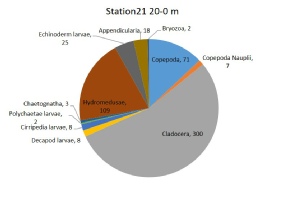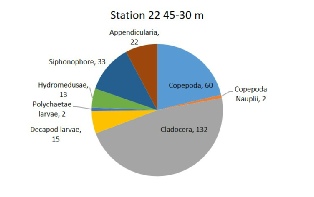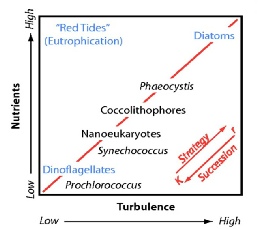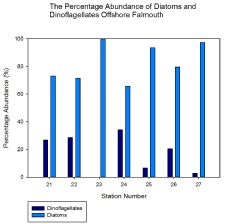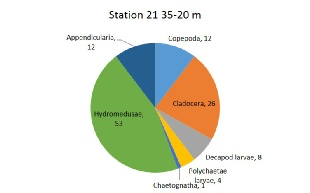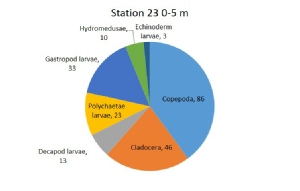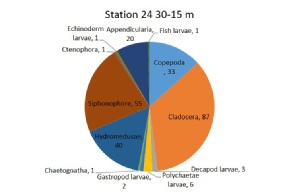



Phytoplankton
Contrasting conditions favour different types of phytoplankton, as demonstrated by
Margalef (Fig.1). Diatoms consist of a dense opal frustule meaning they require turbulent
waters to keep them suspended in the euphotic zone. High amounts of mixing also means
nutrients are constantly replenished in the surface waters. In areas of high nutrient
concentrations diatoms can reproduce quickly and dominate the phytoplankton assemblage.
Dinoflagellates dominate the phytoplankton community when the water column is stratified.
These are small phytoplankton, and therefore don’t require turbulent processes to
keep them suspended in the euphotic zone. They also survive well in areas of low
nutrients as the stratification restricts nutrients from upwelling up to the surface,
meaning they are often found after the diatom dominated spring bloom19.
Our offshore data (Fig.2) supports the Margalef Mandela. A frontal system exists
offshore from Falmouth where the waters are more stratified. They have a warm surface
mixed layer that is depleted in nutrients and cold nutrient rich water below the
thermocline. Dinoflagellates make up approximately 26-30% of the phytoplankton community
at the offshore stations 21, 22, and 24. This is up to 4 times higher than the percentage
of dinoflagellates found at the further inshore stations 23, 25, 26, and 27. These
inshore stations have a higher percentage of diatoms, making up 80-100% of the population.
At station 23, the phytoplankton assemblage is made up entirely of diatoms. Here
the water is extremely well mixed, due to turbulent processes caused by friction
between the tidal current and the seabed. This is proved by the homogeneous profile
of temperature at this station. Diatoms outcompete other types of phytoplankton in
these conditions. This station is also close to the mouth of the Helford River which
would bring an influx of nutrients to the station, creating a high nutrient and turbulent
water column where diatoms would thrive.
Zooplankton
Station 21 (Fig.3&4)
The plankton of the water column varies with depth, as is to be expected due to the
attenuation of light with depth. In surface waters (20-0m) phytoplankton were very
diverse, with diatoms and dinoflagellates each representing half the overall sample.
As a result, a large and diverse zooplankton community is able to grow and reproduce
successfully between the surface and 20m depth (Fig.3). The dominant fauna was Cladocera,
which is unsurprising as it is commonly one of the dominant pelagic populations,
especially in freshwater or eutrophic systems20. They comprised 54.2% of the total
fauna sampled. Another 33% of the sample was made up of copepods and hydromedusae
(Jellyfish), both of which are predators. The remaining 16.8% of the zooplankton
community contained chaetognaths, echinoderm larvae and cirripedia larvae. The high
levels of phytoplankton allowed herbivores to flourish, which in turn allowed predatory
zooplankton such as, chaetognaths and decapods larvae, to flourish However, due to
this huge abundance of cladocera, a large population of hydromedusae were able to
grow.
At deeper depths (20-35m) the plankton community varies significantly. The phytoplankton
levels dropped significantly due to a reduction in Photosynthetically Active Radiation
(PAR) reaching these depths, and diatoms made up 92% of the phytoplankton community.
Due to this, the herbivore zooplankton community was not as large. Hydromedusae are
the dominant family at this depth, comprising 53% of the total count. Cladocera is
not as dominant, only 26% of the total count, as they are herbivorous, and so rely
on phytoplankton as their food source20, which is less prominent here. The high abundance
of cladocera is able to support to the large populations of predators such as Appendicularia,
Decapod larvae, Copepods and Polychaete larvae.
Fig.1: Margalef’s diagram of nutrients and turbulence against phytoplankton growth
Fig.2: Percentage abundance of diatoms and dinoflagellates offshore in Falmouth at
stations 21 to 27.
Station 22 (Fig.5)
In this community there were fewer dinoflagellates within the water, with diatoms
dominating the phytoplankton community (71%) at 14m. The zooplankton net was cast
from 45-30m depth, which will have a significant impact on both the phytoplankton
and zooplankton communities, as less PAR reaches these depths, resulting in less
phytoplankton and consequently a smaller or less diverse zooplankton communtity.
Again, Cladocera dominated the ecosystem, making up 47% of the total zooplankton
abundance, and Copepods were also abundant in this system, at 21% of the sample.
There was a large population of gelatinous predatory zooplankton at this station,
16% of the total count. This station most likely follows the same pattern as the
deep sample taken at the previous station, as the conditions are similar, the main
difference being the levels of phytoplankton. A phytoplankton sample was not taken
at this depth, so it is difficult to draw conclusions. Overall, this station is dominated
by herbivorous Cladocera, which in turn supports the high levels of predators, such
as cnidarians.
Fig.3: Zooplankton abundance and diversity at Station 21 between 20-0m
Fig.4: Zooplankton abundance and diversity at Station 21 between 35-20m
Station 23 (Fig.6)
The phytoplankton sample taken at this station at 4m depth showed that the community
was 100% diatoms. This correlates with the location, as the CTD analysis showed a
well mixed water column at this station. This has an impact on the grazing herbivorous
community, most notably the Cladocera. It can be seen in Fig.6 from the net taken
5-0m in the water column, that they are no longer the dominant zooplankton species,
having an abundance of only 21.5%. The dominant zooplankton species are instead Copepods
(40% of the sample), Gastropod larvae (15.4%) and Polychaete larvae (11%). Most of
these are predatory; however some species of gastropod can have herbivorous larvae21.
Whilst it may seem that there is a small herbivore community, in terms of numbers
they are still abundant, as in a ten ml sample there were 215 total individuals counted,
86 of these being Cladocera. This indicates that the high levels of phytoplankton
still support a large community. The net taken at this sample was considerably shallower
at others, as the station itself was further inshore, and this may account for the
lack of Hydromedusae found here, as they are dependent on currents and this station
was more sheltered then others.
Fig.5: Zooplankton abundance and diversity at Station 22 between 45-30m
Fig.6: Zooplankton abundance and diversity at Station 23 between 5-0m
Fig.7: Zooplankton abundance and diversity at Station 24 between 30-15m
Station 24 (Fig.7)
In the water sample, taken at 30m at this station, there was the highest levels of
phytoplankton seen from any sample. The dominant species had also changed, with dinoflagellates
making up 80% of the community, the highest abundance from any sample. This is to
be expected, as the water column at this station was stratified, which encourages
dinoflagellates to grow rather than doiatoms22. The zooplankton community was diverse,
with twelve different groups represented in the sample taken from 30-15m depth. Cladocera
were the largest group represented, at 34% of the sample, however there three other
large groups; Copepods (13%), Hydromedusae (16%) and Siphonophores (22%). This is
the only sample to include a vertebrate, as one fish larvae was present, which could
indicate that this station was near a spawning ground or fishery. As this system
is so diverse, there are a large number of both herbivorous and predatory species
present.
Disclaimer: The views expressed above are the opinion of the authors only and NOT
that of University of Southampton or National Oceanography Centre, Southampton.
Back to top







